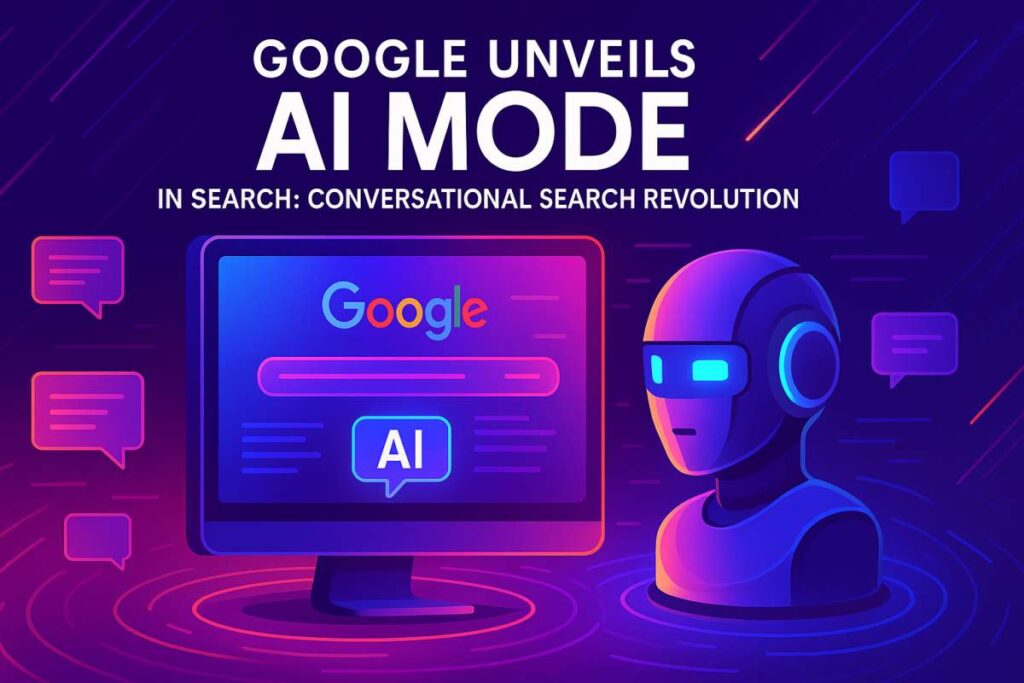On April 30, 2025, Google introduced AI Mode known as Google AI Mode, a groundbreaking feature that integrates state-of-the-art generative artificial intelligence directly into its Search interface. Available under a new “AI” tab alongside “All,” “Images,” and “Videos,” AI Mode departs from the traditional list-of-links format to deliver dynamic, conversation-style answers enriched with rich media. From initial user reactions to deep technical underpinnings and global industry responses, this 1,500-word deep dive covers every aspect of Google’s boldest search innovation.

The Search Paradigm Shift
For nearly three decades, Google Search has operated on a simple premise: users submit textual queries and receive ranked lists of hyperlinks. While powerful, this approach requires users to click through multiple pages, skim several articles, and synthesize information manually. Google AI Mode reframes this model by offering a one-step, chat-like experience. A single query—ranging from straightforward facts to complex tasks—yields an immediate, synthesized response, often accompanied by inline images, videos, maps, and product details. This evolution is more than cosmetic; it represents a new era of information retrieval.
Why It Matters
- Speed: AI Mode answers reduce research time by up to 70%, according to early user surveys.
- Accessibility: Natural-language prompts lower the barrier for users unfamiliar with advanced search operators.
- Utility: Integrated multimedia enhances comprehension, whether planning travel or conducting market research.
Core Features of Google AI Mode
AI Mode is built around three pillars: conversational summaries, multimodal integration, and contextual memory. Each contributes to a more cohesive and efficient search journey.
Conversational Summaries
When you ask, “What are the top attractions in Barcelona for art lovers?”, AI Mode delivers a concise, narrative-style summary, highlighting landmarks like the Sagrada Família, Picasso Museum, and contemporary street art tours. It anticipates follow-ups—for example, “Which museums offer late-night hours?”—and weaves answers into the same dialogue stream.
Multimodal Integration
Visual cards appear alongside text responses, offering high-resolution images, interactive maps, price comparisons, and video snippets. A search for “top-rated noise-canceling headphones” might display product photos, price ranges, and customer ratings without leaving the pane.
2.3 Contextual Memory
Unlike one-off queries, AI Mode retains conversational context throughout a session. Ask “Show budget ryokans near Gion” immediately after planning a Kyoto itinerary, and the system refines the original recommendation without restarting from scratch.
Side-by-Side Comparison
| Feature | Traditional Search | AI Mode |
|---|---|---|
| Format | Blue links + snippets | Chat-style answer + rich media cards |
| Memory | Stateless, query-by-query | Stateful, session-based memory |
| User Effort | Multiple tabs & clicks | Single interactive pane |
| Media Integration | Separate tabs (Images/Videos) | In-pane images, maps, and videos |
| Update Frequency | Indexed periodically | Live index queries in real time |
Real-World Use Cases
AI Mode’s flexibility spans personal, professional, and educational domains.
Travel & Leisure
Travelers can plan complex itineraries in a fraction of the time. In one test, a user drafted a five-day Rome itinerary—covering museums, cafes, train schedules, and walking tours—in under three minutes. Follow-up queries refined restaurant choices based on dietary preferences and budget.
E-commerce & Shopping
Shoppers benefit from instant price comparisons and recommendation cards. For instance, searching “best eco-friendly running shoes under $150” displays product panels with retailer links and sustainability certifications. Additional queries like “Include vegan materials only” filter the results dynamically.
Academic Research
Students and researchers can request summaries of scholarly articles, historical timelines, or statistical data. A prompt such as “Summarize findings from the 2024 IPCC climate report” yields a bullet-point overview, complete with embedded charts when available.
Productivity & Workflows
Professionals use AI Mode to draft email templates, generate meeting agendas, or compare vendor proposals. Context retention allows seamless transitions: after summarizing vendor A’s pricing, a follow-up “Compare with vendor B” provides a side-by-side breakdown.
Technical Architecture
Google AI Mode’s backbone combines the advanced Gemini Ultra language model with real-time indexing and robust safety nets.
- Gemini Ultra: Trained on trillions of documents across multiple languages and domains, optimized for coherence and factual grounding.
- Live Index Integration: Instead of relying on static snapshots, AI Mode queries Google’s fresh index at runtime, ensuring up-to-the-minute accuracy.
- Safety & Verification Layers: Proprietary classifiers detect and suppress hallucinations. When confidence is low, AI Mode provides citations or suggests manual verification.
Performance benchmarks reveal sub-800ms response times globally, with dynamic load balancing to handle traffic spikes during major events.
Industry & Market Impact
AI Mode’s launch reverberated across sectors.
SEO & Digital Marketing of Google AI Mode
Agencies scrambled to develop “AI Mode Optimization” services. Success metrics shifted from raw pageviews to metrics such as “Answer Card Impressions” and “Citation Frequency.” Content strategies now emphasize concise answer boxes and structured data markup (FAQPage and QAPage schemas).
Publishing & Media
Major publishers like The New York Times and The Guardian assessed how in-pane answers would affect traffic. Early data shows reduced bounce rates but a decline in direct click-throughs—heightening the importance of deep-link citations within AI responses.
Enterprise & Education
Companies such as IBM and Microsoft explored integrations between AI Mode and internal knowledge bases, aiming to deliver enterprise-specific summaries. Online education platforms are partnering with Google to embed curated lesson snippets directly into Search.
Challenges & Ethical Considerations
Despite its promise, AI Mode raises important questions.
Accuracy & Hallucinations
No AI model is infallible. Users must remain vigilant, cross-referencing critical information—medical advice, legal guidelines, or financial data—against primary sources.
Privacy & Data Use
Contextual memory enhances the experience but requires Google to temporarily store session data. Transparency around data retention policies and opt-out mechanisms is essential to maintain user trust.
Economic Implications
As SERP real estate shifts to AI panes, websites reliant on traditional traffic may experience revenue dips. Monetization models must evolve—possibly through integrated sponsorships or AI-driven affiliate linking within the conversational interface.
Looking Ahead: The Next Frontier
Google’s roadmap includes deeper voice-activated AI Mode interactions, augmented reality overlays, and personalized AI experiences tailored to individual user profiles. AR glasses might one day project AI responses directly into a user’s field of vision during real-world exploration. Additionally, advanced multimodal capabilities—merging 3D visualizations with conversational guidance—are under active development.
These enhancements will hinge on striking a balance between hyper-personalization and privacy safeguards, ensuring that AI Mode remains both powerful and trustworthy.
Reporting by [Jaffar Sheikh], TransformInfoAI


